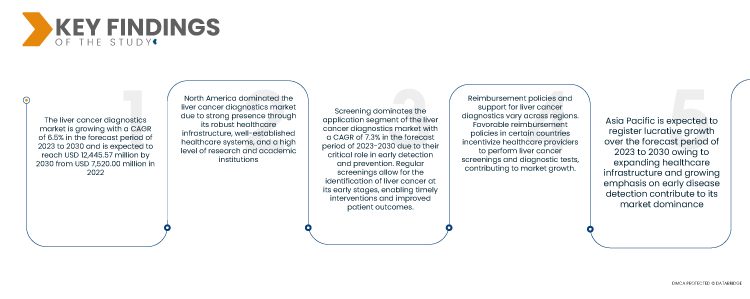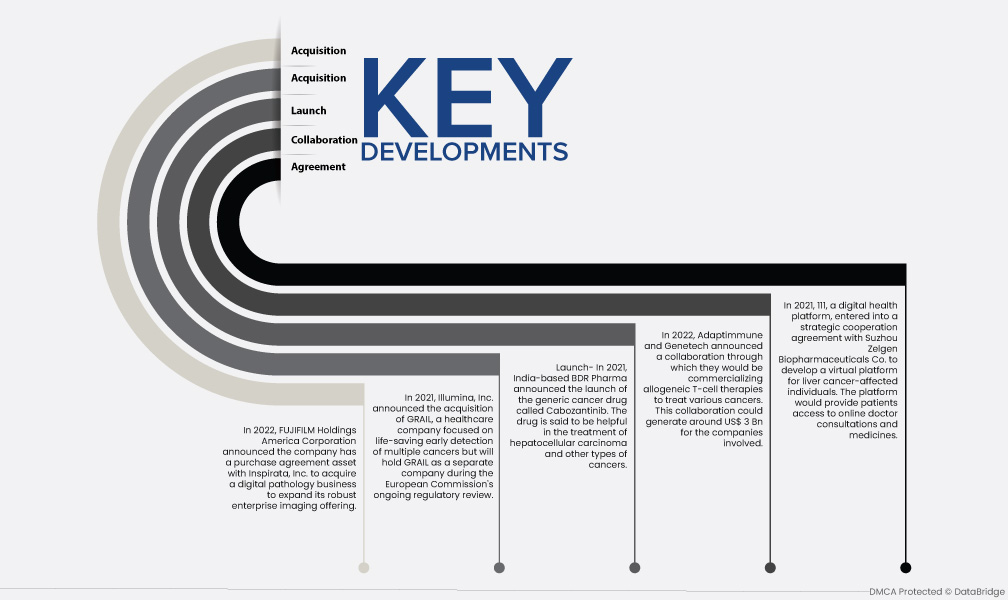The global liver cancer diagnostics market is poised for growth in the coming years. Manufacturers are actively involved in research and development activities to introduce novel diagnostic services, enhancing the overall market landscape. The rising demand for high-quality healthcare services for liver cancer and a growing preference for preventative health checkups are expected to fuel market growth. These factors collectively contribute to an optimistic outlook for the global liver cancer diagnostics market, promoting early detection and improved patient care.
Access Full Report @ https://www.databridgemarketresearch.com/reports/global-liver-cancer-diagnostics-market
Data Bridge Market Research analyses that the Global Liver Cancer Diagnostics Market is growing with a CAGR of 6.5% in the forecast period of 2023 to 2030 and is expected to reach USD 12,445.57 million by 2030 from USD 7,520.00 million in 2022. Growing healthcare expenditure worldwide, coupled with increasing investments in healthcare infrastructure, boosts the accessibility and availability of liver cancer diagnostic services. This supports market growth by facilitating early diagnosis and better patient outcomes.
Key Findings of the Study
Rising incidence of liver cancer is expected to drive the market's growth rate
The rising incidence of liver cancer globally is a key driver for diagnostics. Factors such as hepatitis B and C infections, excessive alcohol consumption, obesity, and non-alcoholic fatty liver disease contribute to the increasing prevalence of liver cancer. Timely and accurate diagnostics are essential for early detection and intervention. The growing need to diagnose and manage liver cancer cases effectively drives the demand for advanced diagnostic tools and services in the market.
Report Scope and Market Segmentation
|
Report Metric
|
Details
|
|
Forecast Period
|
2023 to 2030
|
|
Base Year
|
2022
|
|
Historic Years
|
2021 (Customizable to 2015-2020)
|
|
Quantitative Units
|
Revenue in USD Million, Volumes in Units, Pricing in USD
|
|
Segments Covered
|
Test Type (Imaging Test, Biopsy, Genomic Test, and Others), Cancer Stages (Stage 0, Stage I, Stage II, Stage III, and Stage IV), Cancer Type (Primary Liver Cancer and Secondary Liver Cancer), Product (Platform-Based Products, Instrument Based Products, Kits and Reagents, and Other Consumables), Technology (Fluorescent In Situ Hybridization, Next Generation Sequencing, Fluorimmunoassay, Comparative Genomic Hybridization, Immunohistochemical, and Others), Application (Screening, Diagnostic and Predictive, Prognostic, and Research), Gender (Female and Male), End-User (Hospitals, Diagnostic Centers, Cancer Research Centers, Academic Institutes, Ambulatory Surgical Centers, and Others), Distribution Channel (Direct Tender, Retail Sales, and Others)
|
|
Countries Covered
|
U.S., Canada and Mexico in North America, Germany, France, U.K., Netherlands, Switzerland, Belgium, Russia, Italy, Spain, Turkey, Rest of Europe in Europe, China, Japan, India, South Korea, Singapore, Malaysia, Australia, Thailand, Indonesia, Philippines, Rest of Asia-Pacific (APAC) in the Asia-Pacific (APAC), Saudi Arabia, U.A.E, South Africa, Egypt, Israel, Rest of Middle East and Africa (MEA) as a part of Middle East and Africa (MEA), Brazil, Argentina and Rest of South America as part of South America.
|
|
Market Players Covered
|
Siemens Healthcare GmbH (Germany), Koninklijke Philips N.V.(Netherland), Agilent Technologies, Inc. (U.S.), Illumina, Inc. (U.S.), Epigenomics AG (Germany), Tebubio, Thermo Fisher Scientific Inc. (U.S.), QIAGEN(U.S.), F. Hoffmann-La Roche Ltd (Switzerland), Fujirebio(Japan), Diagnostic Biosystems Inc. (U.S.), FUJIFILM Corporation (Japan), BD(U.S.), Q-LINE BIOTECH PVT LTD. (India), MOLGEN (Netherlands), BIOCEPT, INC. (U.S.), Sysmex Corporation (Japan), Boditech Med Inc., Elabscience Biotechnology Inc. (U.S.), Hipro Biotechnology Co., Ltd. (China), Altogen Biosystems (U.S.), Tosoh India Pvt. Ltd. (India), ABK Biomedical Inc.(Canada), Diazyme Laboratories, Inc. (U.S.), AB Sciex Pte Ltd. (Subsidiary of Danaher) (U.S.), among others
|
|
Data Points Covered in the Report
|
In addition to the insights on market scenarios such as market value, growth rate, segmentation, geographical coverage, and major players, the market reports curated by the Data Bridge Market Research also include depth expert analysis, patient epidemiology, pipeline analysis, pricing analysis, and regulatory framework.
|
Segment Analysis:
The liver cancer diagnostics market is segmented on the basis of test type, cancer type, cancer stages, product, application, technology, gender, end-user, and distribution channels.
- On the basis of test type, the liver cancer diagnostics market is segmented into imaging test, biopsy, genomic test, and others. Genomic test dominates the test type segment of the liver cancer diagnostics market with a CAGR of 7.2% in the forecast period of 2023-2030 due to their crucial role in liver cancer diagnostics. Techniques such as computed tomography (CT), magnetic resonance imaging (MRI), and ultrasound provide detailed visualization of the liver, aiding in accurate diagnosis, staging, and treatment planning.
In 2023, Genomic test will dominate the test type segment of the liver cancer diagnostics market
In 2023, Genomic test will dominate the test type segment of the liver cancer diagnostics market owing to their critical function in the detection of liver cancer. A precise diagnosis, staging, and treatment plan can be made with the help of methods such as computed tomography (CT), magnetic resonance imaging (MRI), and ultrasound with a CAGR of 7.2% in the forecast period of 2023-2030.
- On the basis of cancer stages, the liver cancer diagnostics market is segmented into stage 0, stage I, stage II, stage III, and stage IV. Stage III dominates the cancer stages segment of the liver cancer diagnostics market with a CAGR of 6.9% in the forecast period of 2023-2030 due to accurate staging for appropriate treatment planning, including surgery, chemotherapy, radiation, and targeted therapies, driving the demand for comprehensive diagnostic and monitoring tools.
- On the basis of cancer type, the liver cancer diagnostics market is segmented into primary liver cancer and secondary liver cancer. Secondary liver cancer dominates the cancer type segment of the liver cancer diagnostics market with a CAGR Of 6.8% in the forecast period of 2023-2030 due to its high prevalence. It occurs when cancer spreads to the liver from other primary cancer sites, necessitating precise diagnostics to identify the origin and determine appropriate treatment strategies for improved patient outcomes.
- On the basis of product, the liver cancer diagnostics market is segmented into platform-based products, instrument based products, kits and reagents, and other consumables. Platform-based products dominate the product segment of the liver cancer diagnostics market with a CAGR of 7.4% in the forecast period of 2023-2030 due to their versatility and efficiency in liver cancer diagnostics. These products provide a standardized platform or system that can perform multiple diagnostic tests, enabling streamlined workflows, increased throughput, and cost-effective diagnostic solutions in the market.
In 2023, Platform-based products dominates the product segment of the liver cancer diagnostics market
In 2023, Platform-based products dominates the product segment of the liver cancer diagnostics market owing to their adaptability and effectiveness in detecting liver cancer. These products offer a standardized platform or system that is capable of carrying out a number of diagnostic tests, facilitating more efficient workflows and market-ready diagnostic solutions with lower costs with a CAGR of 7.4% in the forecast period of 2023-2030.
- On the basis of technology, the liver cancer diagnostics market is segmented into fluorescent in situ hybridization, next generation sequencing, fluorimmunoassay, comparative genomic hybridization, immunohistochemical, and others. Fluorescent in situ hybridization dominates the technology segment of the liver cancer diagnostics market with a CAGR of 8.0% in the forecast period of 2023-2030 due to its ability to identify specific genetic abnormalities and chromosomal rearrangements. FISH enables precise detection of biomarkers, aiding in accurate diagnosis, prognosis, and personalized patient treatment selection.
- On the basis of application, the liver cancer diagnostics market is segmented into screening, diagnostic and predictive, prognostic, and research. Screening dominates the application segment of the liver cancer diagnostics market with a CAGR of 7.3% in the forecast period of 2023-2030 due to their critical role in early detection and prevention. Regular screenings allow for the identification of liver cancer at its early stages, enabling timely interventions and improved patient outcomes.
- On the basis of gender, the liver cancer diagnostics market is segmented into female and male. Male dominates the gender segment of the liver cancer diagnostics market with a CAGR of 6.7% in the forecast period of 2023-2030 due to higher prevalence of liver cancer compared to females. Understanding gender-specific risk factors and tailored diagnostic approaches are crucial in addressing the specific needs of male patients.
- On the basis of end-user, the liver cancer diagnostics market is segmented into hospitals, diagnostic centers, cancer research centers, academic institutes, ambulatory surgical centers, and others on the basis of distribution channel, the liver cancer diagnostics market is segmented into direct tender, retail sales, and others. Hospitals dominate the end user segment of the liver cancer diagnostics market with a CAGR of 7.9% in the forecast period of 2023-2030 due to their central role in providing comprehensive healthcare services. They house advanced diagnostic technologies, specialized healthcare professionals, and multidisciplinary care, facilitating accurate diagnosis, staging, and treatment planning for liver cancer patients.
Major Players
Data Bridge Market Research recognizes the following companies as the major liver cancer diagnostics market players in liver cancer diagnostics market are FUJIFILM Corporation (Japan), BD (U.S.), Q-LINE BIOTECH PVT LTD. (India), MOLGEN (Netherlands), BIOCEPT, INC. (U.S.), Sysmex Corporation (Japan), Boditech Med Inc., Elabscience Biotechnology Inc. (U.S.)
Market Development
- In 2022, FUJIFILM Holdings America Corporation announced the company has a purchase agreement asset with Inspirata, Inc. to acquire a digital pathology business to expand its robust enterprise imaging offering.
- In 2021, Illumina, Inc. announced the acquisition of GRAIL, a healthcare company focused on life-saving early detection of multiple cancers but will hold GRAIL as a separate company during the European Commission's ongoing regulatory review.
- In 2021, India-based BDR Pharma announced the launch of a generic cancer drug called Cabozantinib. The drug is said to be helpful in the treatment of hepatocellular carcinoma and other types of cancers.
- In 2022, Adaptimmune and Genetech announced a collaboration through which they would be commercializing allogeneic T-cell therapies to treat various cancers. This collaboration could generate around US$ 3 Bn for the companies involved.
- In 2021, 111, a digital health platform, entered into a strategic cooperation agreement with Suzhou Zelgen Biopharmaceuticals Co. to develop a virtual platform for liver cancer-affected individuals. The platform would provide patients access to online doctor consultations and medicines.
Regional Analysis
Geographically, the countries covered in the liver cancer diagnostics market report are U.S., Canada and Mexico in North America, Germany, France, U.K., Netherlands, Switzerland, Belgium, Russia, Italy, Spain, Turkey, Rest of Europe in Europe, China, Japan, India, South Korea, Singapore, Malaysia, Australia, Thailand, Indonesia, Philippines, Rest of Asia-Pacific (APAC) in the Asia-Pacific (APAC), Saudi Arabia, U.A.E, South Africa, Egypt, Israel, Rest of Middle East and Africa (MEA) as a part of Middle East and Africa (MEA), Brazil, Argentina and Rest of South America as part of South America.
As per Data Bridge Market Research analysis:
North America is the dominant region in liver cancer diagnostics market during the forecast period 2023-2030
North America's dominance in the liver cancer diagnostics market is attributed to several factors. The region has witnessed significant investments in research and development, driving innovation and advancements in diagnostic technologies. Within North America, the U.S. holds a strong presence due to its robust healthcare infrastructure, well-established healthcare systems, and a high level of research and academic institutions. These factors contribute to the U.S.'s dominance in the region's liver cancer diagnostics market.
Asia-Pacific is estimated to be the fastest-growing region in liver cancer diagnostics market the forecast period 2023-2030
Asia-Pacific is expected to grow during the forecast period due to China's dominance in the liver cancer diagnostics market in the Asia-Pacific region can be attributed to several factors. The country excels in mass production of liver cancer diagnostics products, meeting the increasing demand within China and emerging markets in the region. Furthermore, China's expanding healthcare infrastructure and growing emphasis on early disease detection contribute to its market dominance. These factors position China as a key player in the liver cancer diagnostics market in the Asia-Pacific region.
For more detailed information about the liver cancer diagnostics market report, click here – https://www.databridgemarketresearch.com/reports/global-liver-cancer-diagnostics-market












